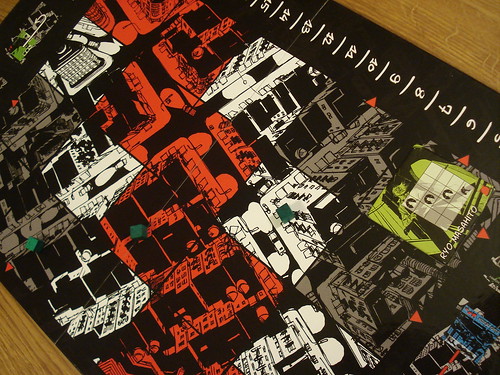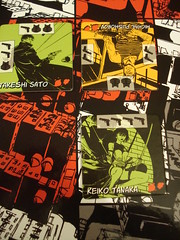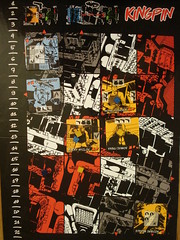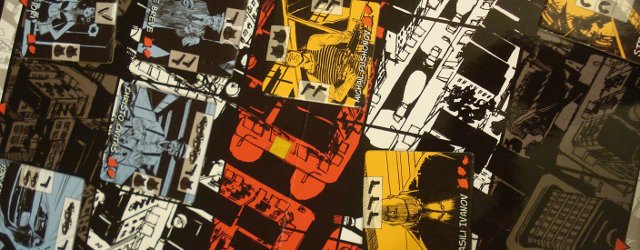| Strategy | Luck |
|---|---|
| Interaction | Components & Design |
| Complexity | Score |
The (unnamed) city is ripe for the picking. There is drugs to be sold, protection rackets to be ran and politicians to be bought, and you would rather be damned than let those fat profits go to the competition. You are the local boss of either the Mafia, the Yakuza or a russian crime syndicate, and with your team of eight specialists you’re out to secure your hold on the city. The city consists of four by five squares, a very small area to set up a strategy in. There are two variants of the city on the two sides of the game board, but they share the same general set up: the short ends of the board are the player’s headquarters, the red stripe in the centre is No Man’s Land that the syndicates are fighting over.
These features of the terrain are tied to the first two ways to win the game: if you manage to move one of your gangsters through the enemy HQ, you win. If you manage to position three of your boys in No Man’s Land while none of the opposition are there, you win. You also win if you eliminate all enemy gangsters. And finally, if your opponent runs out of turns before you do, you win. Kingpin was designed by someone with an aversion to defensive play: each player has 25 moves in the game, indicated by a counter on the side of the board, but only moving counts, attacking is free. This gives everyone a strong incentive not to turtle up in their head quarters.

And so, finally, we come to the main actors: the boys. Your team of specialists. In continuation of a sad, sad trend in our recent reviews, the gangsters on your team are not meeple – I know it’s shocking, but please don’t stop reading yet. Kingpin has two good reasons why the gangsters are printed on paper squares: they present a lot of necessary information and they are directional. All of your gangsters have a portrait and have their name and their toughness printed along the bottom. Most of your gangsters have symbols along one,two or three edges giving their damage in a shootout (gun symbols), their damage in a raid (car symbol), their armour (bullet-proof vest) and their support ability (bullets). Those symbols apply in the direction they are facing, so the damage and your gangsters do and the protection they have depends on which way they are attacking or being attacked. For example: Michail Pushonov, obviously of the Russians, has two points of armour to the front but can not attack in that direction. He also has two guns of attack damage to the left and right, but no protection. No one has any abilities on the bottom of their chit: if you let the enemy get behind you, you’re dead, end of story.
Some gangsters are snipers and don’t bother with all those symbols other than toughness. Instead, their chit has a grid showing the squares they can shoot at, relative to their position. When a sniper is on the board, these squares are marked with little cubes of his colour to show that they are threatened by a sniper. A sniper alone can not kill anyone, not even an enemy sniper that has only one point of toughness – instead, being on a square in the cross-hair reduces the toughness of the target so they are easier for someone else to finish off. Also, snipers are the only ones to ignore armour.
You start the game with no gangsters on the board and three gangsters ready to start the assault. The first few turns, you don’t really have an option other than moving – which is bad since it reduces your turn counter. Moves are pretty straight-forward:
- You can have one of your boys enter the battlefield on an empty square of your head quarter, facing any direction. When you place a new gangster on the board, you immediately draw a new one from your stack so you always have three available – until they run out
- You can move one gangster by one square horizontally or vertically and turn him or her in any direction
- You can turn a gangster in place.
- You can do a castling move, switching two adjacent gangsters.

Once you grow tired of decreasing your turn counter – and once your opponent is in range – it’s time for someone to die. As mentioned above, there is two different ways to attack: either in a shootout, or in a raid. Fights can be a bit confusing in the first game because not only the attacker and defender get involved but also all their colleagues around them, but it turns out to be much simpler than it looks.
Lets look at shootouts first. Attacker and defender have to be directly adjacent and will fire at each other doing as much damage as they have guns pointing in that direction, reduced by the other guys armour. So far it’s easy. Both attacker and defender also shoot at every other enemy next to them, with the guns they have facing that enemy. And all adjacent enemies with guns pointing at attacker and defender take a shot at them, too. At least these secondary participants do not fire at each other – it doesn’t matter that this rule contradicts every single gangster movie in existence, it would just be too confusing. And for some extra fun every gangster that has a friendly support bullet pointed at them does one extra point of damage in every direction that he can shoot (has gun symbols). Everyone taking as much damage as their toughness or more – remember to consider snipers here – dies. As you can see being surrounded is a very bad thing indeed.
Raids are not much different from shootouts, but the attacker must move exactly one square straight towards their target first – their damage done to that target is given by the cars pointing in that direction, not the guns. They still shoot at everyone else around them using their guns, and the defenders guns are used just like in a shootout. Only the attacker gets to use the (usually higher) raid damage.
Both kinds of attack can only be performed if the target dies as the result – shooting to scare people or wound them is just a waste of ammo. The winner has to move into the square previously occupied by his target, attacking a gangster in the middle of his friends is a short-lived victory.

The three syndicates have different gangsters available, and their abilities dictate a different play style for each of them. The Russians mostly have heavy hitters in big armour, but are most comfortable fighting in close quarters; the Mafia specialises in raids and quick movements but are not as durable and the Yakuza has an edge in long range suppression with their two snipers but is neither very fast nor very tough. This asymmetric design of the different factions has a big potential for balance problems, but Kingpin pulls it off nicely. None of the syndicates has a big advantage over any of the others, they just force you to adapt your strategy. The Yakuza seems to be a bit harder to play in the beginning – it’s not easy to properly position your snipers because their field of influence is far away from their tile, and they have enough range that they shoot over the edge of the board when standing in the wrong place – but once you mastered that aspect, their chances to win are no better or worse than the other syndicates’.
Despite the depressing lack of meeple, Kingpin has a very good design. It’s not a coincidence that the illustrations have more than superficial similarity to Frank Miller’s Sin City – the comic series is given as one of the inspirations for Kingpin – and the style fits the game very well. I also want to express my thanks to the creators for choosing names that, at least to someone not speaking Italian, Russian or Japanese, sound believable. There is only so many times I can chuckle at names like Ivan Thugoff or Marcello Masturbatori, and by now I only forgive that style of naming in things related to Asterix.
Kingpin is a game with a lot more depth than you think when reading the rules and does not belong into the charge-in-with-guns-blazing category at all. The confined space makes it hard to out-manoeuvre an opponent and even harder to draw him into a position where you can attack without opening yourself to retaliation. At the same time, the turn counter forces you into action – the twenty-five moves you have available is not a lot of time, even on the small board.

While fortifying in your home base may sounds like a good idea for the second player – their opponent will run out of turns first – there is two problems with that strategy. Your opponent only needs to make one successful attack to reverse the situation, and if that happens with three turns left and you not set up for attack, you’re in trouble. Also, turtling up in your HQ leaves your opponent with easy access to No Man’s Land and thus another route to victory – but trying to defend No Man’s Land with the eight gangsters available to you has the risk of opening a fatal hole in your defences that one of the opponent’s raiders may use to reach your head quarter in just one turn.
It is this tension between space and time constraints and the different victory conditions that makes Kingpin a very interesting game for two players. It doesn’t have the same depth as chess; even taking into account the orientation of the gangster tiles the decision space is much smaller. Nevertheless, making your move trying to take into account all the ways it could shoot you in the foot later is not decision of a few seconds, if you want to win you’d better be prepared to invest some thought into your moves, and never forget to take all the possibilities how your opponent could win into account.
The suggested age of 18 and above, as printed on our box, has nothing to do with the complexity and mechanics of the game, by the way, but was only earned for the subject matter and maybe the included DVD.
With apologies to publisher and authors for not having their names 100% correct, this is due to purely typographical issues and we decided that everyone would be happier the way it is now than they would be with question marks in their name.















Thx for review! Reading the text I had a impression that you have deep understanding of Kingpin rules so it’s clear for me that you spend some time on the game. Taking into account this fact I’m really happy that you like Kingpin:) Hope that it’s not a one-time adventure and you will be returning to our game in the future:) If you want u can try to play with more complex rules (with no time limit, and all gangsters available for the start; more info u can find in the instruction) witch exclude completely randomness from the game .
If you (or any other user) like the art of Robert Adler you can follow the link to KAG (Kingpin Avatar Generator) and create your own avatar: http://www.kuzniagier.com/kingpin/avatar/
Thx again for your effort!
The Avatar Generator is pretty cool =)
Glad you like the review, and we’ll definitely keep playing Kingpin.